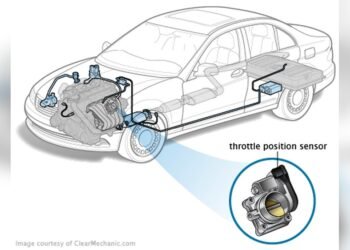**Chrysler Pacifica Transmission Problems: What You Need to Know** If you own a Chrysler Pacifica or are thinking about buying one, you’re probably focused on its family-friendly features, sleek design, and impressive comfort. But there’s one issue you can’t afford to overlook—transmission problems.
These issues can creep up unexpectedly, leaving you frustrated, stressed, and facing costly repairs. You might have already noticed unusual noises, jerky shifting, or a warning light on your dashboard. Or maybe you’re simply trying to avoid potential headaches in the future.
Either way, understanding the common transmission problems in the Chrysler Pacifica can save you time, money, and a lot of frustration. We’ll break down the key symptoms, causes, and solutions to Chrysler Pacifica transmission issues. By the end, you’ll feel more confident about tackling these problems head-on and keeping your vehicle running smoothly. Let’s dive in—you don’t want to miss this!

Credit: www.miloschusedcars.com
Common Transmission Issues
The Chrysler Pacifica is a popular family minivan. Yet, many owners report transmission problems. These issues can affect driving performance and safety. Understanding the common problems can help you identify symptoms early. Below are some of the most reported transmission issues.
Slipping Gears
Slipping gears is a frequent complaint among Chrysler Pacifica owners. This happens when the transmission unexpectedly shifts gears. You may notice a sudden loss of power while driving. It can make accelerating or maintaining speed difficult. Slipping gears also increase the risk of accidents.
Hard Shifting
Hard shifting occurs when the transmission jerks during gear changes. Drivers often feel a strong jolt or hear a loud clunk. This issue can cause discomfort and strain on the vehicle. Over time, it may damage other parts of the transmission system. Regular maintenance can reduce this risk.
Transmission Fluid Leaks
Transmission fluid leaks are another common problem. You might see red or brown fluid under your vehicle. Low fluid levels can cause overheating and poor transmission performance. Ignoring leaks can lead to more severe and costly damage. Inspecting for leaks regularly can prevent larger issues.
Delayed Engagement
Delayed engagement happens when the vehicle hesitates to move after shifting gears. This is most noticeable when shifting from park to drive or reverse. The delay can range from a few seconds to longer. It may signal internal wear or a fluid pressure issue. Addressing this early can help avoid costly repairs.
Signs Of Transmission Trouble
Your Chrysler Pacifica’s transmission is the backbone of its performance. When it starts to show signs of trouble, early detection can save you from costly repairs. But what should you look out for? Below are key symptoms that signal your transmission might be crying out for help.
Unusual Noises
Does your Pacifica make strange sounds when you shift gears? Clicking, whining, or grinding noises can be an early warning sign. These noises often point to worn-out parts or low transmission fluid levels. Ignoring them might lead to bigger problems, so take action as soon as you hear something off.
Burning Smell
Ever stepped out of your car and noticed a sharp burning odor? That smell could mean your transmission fluid is overheating. Overheated fluid loses its ability to lubricate and cool the transmission effectively. If you catch this smell, check your fluid levels or consult a mechanic right away.
Dashboard Warning Lights
Your dashboard isn’t just for decoration—it’s a communication hub. If the transmission warning light pops up, don’t ignore it. It’s your car’s way of telling you there’s a problem. Sometimes, the issue might be as simple as low fluid, but other times it could be a more serious internal malfunction.
Sudden Loss Of Power
Have you ever pressed the gas pedal only to feel your car hesitate or lose power? This could be a sign of a slipping transmission. Slipping gears can prevent your car from accelerating properly. If this happens, it’s not just annoying—it’s dangerous. Get your vehicle checked immediately.
What’s next? Keep an eye out for these signs and act quickly. Neglecting small issues can lead to major repairs down the road. Have you experienced any of these symptoms in your Pacifica? If so, share your story in the comments below—it might just help another reader!
Diagnosing The Problem
Diagnosing transmission problems in your Chrysler Pacifica might feel overwhelming, but it doesn’t have to be. By breaking it into simple steps, you can narrow down the issue and decide the best course of action. Whether you’re experiencing slipping gears, strange noises, or warning lights, these steps will guide you toward identifying the root cause.
Checking Transmission Fluid
Start by examining the transmission fluid. Low or dirty fluid is a common cause of transmission problems. Pull out the dipstick, wipe it clean, and insert it back in to check the level and color.
If the fluid looks dark or smells burnt, it’s likely time for a change. Bright red or pink fluid is a good sign, but a low level might indicate a leak. Addressing fluid issues early could save you from costly repairs later.
Scanning For Error Codes
Use an OBD-II scanner to check for error codes. These scanners plug into your vehicle and can reveal issues your Pacifica’s computer system has detected. Many auto parts stores offer free scanning services if you don’t own one.
Common transmission-related codes might point to sensor malfunctions, pressure issues, or solenoid problems. Once you have the codes, look them up or consult a mechanic to understand what they mean.
Inspecting For Visible Damage
Pop the hood and inspect the transmission system for any visible damage. Look for cracked hoses, loose connections, or fluid leaks around the transmission housing. These are often telltale signs of a problem.
Don’t forget to check underneath your vehicle. A puddle of fluid beneath your car could signal a transmission seal issue. Catching these signs early can prevent more extensive damage.
Test Driving For Symptoms
Take your Pacifica for a short test drive to observe how it behaves. Pay attention to how smoothly it shifts between gears and whether you feel any jerking or hesitation. These symptoms often indicate internal transmission issues.
Listen closely for unusual sounds like grinding or whining. If the car struggles to accelerate or revs too high without gaining speed, it’s time to consult a professional. How does your car feel during the drive? Trust your instincts—if something seems off, it probably is.
Diagnosing your Chrysler Pacifica’s transmission problem doesn’t have to be daunting. By following these straightforward steps, you can quickly pinpoint the issue and decide your next move. What’s the first sign you noticed in your vehicle? Share your experience below!

Credit: georgia-lemon-law.info
Diy Troubleshooting Tips
The Chrysler Pacifica is a popular minivan, but its transmission can face issues. Many owners prefer solving minor problems themselves before seeking professional help. DIY troubleshooting can save time and money. Below are simple tips for addressing common transmission concerns.
Topping Off Transmission Fluid
Low transmission fluid levels can cause shifting problems and overheating. Check the fluid level using the dipstick under the hood. Ensure the vehicle is on a level surface. If the fluid is low, add the correct type specified in your manual. Avoid overfilling as it can harm the transmission.
Resetting The Transmission System
Transmission issues can sometimes be fixed by resetting the system. Disconnect the negative battery cable and wait for 30 minutes. Reconnect the cable and start the car. This can clear temporary glitches in the transmission’s control module.
Inspecting For Loose Connections
Loose connections in the transmission wiring can cause shifting delays. Open the hood and inspect the transmission wiring harness. Look for damaged or loose wires. Tighten or replace any visibly worn connectors to ensure proper communication.
Cleaning The Transmission Pan
A dirty transmission pan can affect fluid flow and transmission performance. Drain the fluid and remove the pan carefully. Clean it with a lint-free cloth and degreaser. Check for metal debris, as it might indicate internal damage. Reinstall the pan and refill the transmission fluid.
When To Seek Professional Help
Experiencing transmission issues with your Chrysler Pacifica can be frustrating. Identifying the right time to seek professional help is crucial. Ignoring transmission problems can lead to costly repairs and unsafe driving conditions. Below are key signs that indicate professional assistance is necessary.
Persistent Warning Lights
Dashboard warning lights often signal transmission trouble. If the transmission light stays on or repeatedly activates, it’s a sign of a deeper issue. Professional diagnostics can pinpoint the problem and prevent further damage. Don’t delay addressing persistent warning lights.
Recurring Fluid Leaks
Transmission fluid leaks shouldn’t be ignored. Leaks can cause low fluid levels, leading to overheating and mechanical problems. If you notice reddish fluid under your vehicle, it’s time to contact a mechanic. Recurring leaks often require specialized repair services.
Major Mechanical Failures
Grinding noises, slipping gears, or difficulty shifting are serious mechanical issues. These symptoms usually indicate internal damage to the transmission system. A professional can inspect and repair these failures to restore smooth operation.
Transmission Overhaul Needs
Severe wear and tear can necessitate a complete transmission overhaul. Signs include erratic shifting, excessive vibrations, or the vehicle refusing to move. A certified technician can assess the situation and recommend an overhaul if needed.
Preventative Maintenance
Preventative maintenance is essential to keep your Chrysler Pacifica’s transmission healthy. It reduces the chances of costly repairs and prolongs the vehicle’s life. By following a few simple steps, you can avoid common transmission issues. Let’s explore key practices to maintain your Pacifica’s transmission system effectively.
Regular Fluid Changes
Transmission fluid keeps the system lubricated and prevents overheating. Over time, the fluid can break down or become dirty, leading to problems. Change the transmission fluid as recommended in the owner’s manual. Use the type of fluid specified for your Chrysler Pacifica. Ignoring fluid changes can lead to wear and poor performance.
Avoiding Overloading
Overloading your vehicle puts extra strain on the transmission. Excess weight causes the system to overheat and wear out faster. Check your owner’s manual for weight limits and avoid exceeding them. This simple step can significantly reduce transmission stress and potential damage.
Monitoring Driving Habits
Aggressive driving can harm your transmission over time. Rapid acceleration and abrupt braking increase wear on the system. Maintain steady speeds and avoid unnecessary stress on the engine. Smooth driving habits help extend the life of your Pacifica’s transmission.
Scheduling Routine Checkups
Regular inspections by a professional can catch issues early. Mechanics can identify leaks, worn parts, or other potential problems. Schedule routine checkups based on your vehicle’s maintenance schedule. Early detection helps prevent minor issues from becoming major repairs.

Credit: lemberglaw.com
Frequently Asked Questions
What Are Common Transmission Problems In Chrysler Pacifica?
Transmission slipping, rough shifting, and delayed response are common issues reported by Chrysler Pacifica owners.
How Do I Know If My Pacifica Transmission Is Failing?
Signs include loud noises, gear hesitation, fluid leaks, and warning lights on the dashboard.
Can Chrysler Pacifica Transmission Issues Be Fixed Easily?
Some problems, like fluid leaks, are simple to fix, but major repairs may require professional help.
What Is The Cost Of Repairing Pacifica Transmission Problems?
Repair costs vary but can range from $300 for minor issues to $4,000 for major repairs.
How Can I Prevent Chrysler Pacifica Transmission Problems?
Regular maintenance, fluid checks, and timely repairs can help prevent transmission issues in your Pacifica.
Conclusion
Dealing with Chrysler Pacifica transmission problems can be frustrating and stressful. Regular maintenance helps identify issues early and avoid major repairs. Pay attention to warning signs like strange noises or gear slipping. Addressing problems quickly can save money and extend your vehicle’s lifespan.
If issues persist, consult a trusted mechanic for expert advice. Staying proactive ensures smoother drives and fewer breakdowns. Proper care goes a long way in keeping your Pacifica reliable. Always prioritize safety and act promptly to resolve transmission concerns. Your vehicle deserves attention to perform its best on the road.















